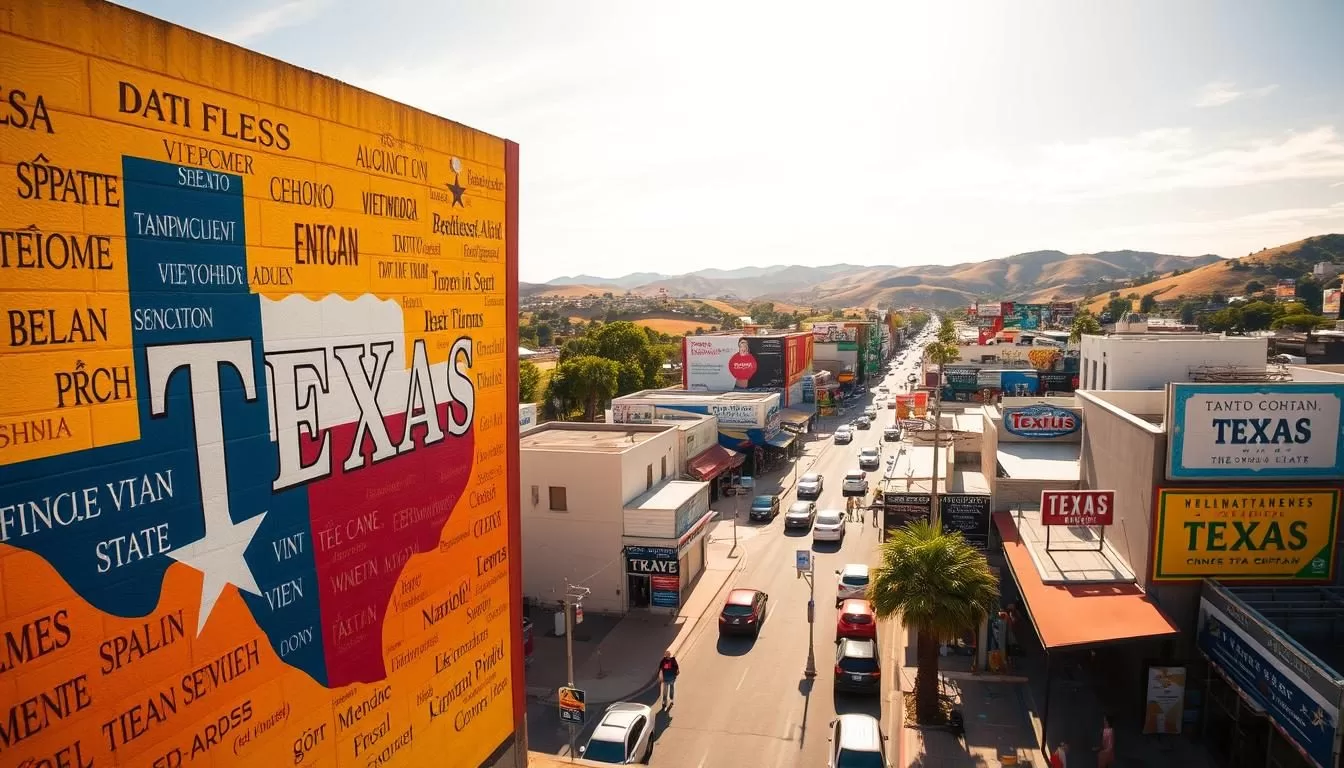✓ Accommodations✓ Flights✓ Rental Cars✓ Tours & Activities
You’ll discover that the Lone Star State has no officially designated state language, despite its rich linguistic diversity.
The population of Texas is diverse, with 64.9% of residents speaking only English at home, while 28.8% speak Spanish at home.
As you explore the state’s linguistic landscape, you’ll find a tapestry of languages, including Vietnamese, Chinese, Arabic, and many more, reflecting Texas’s position as a global immigration destination.
Throughout its history, language policies have evolved significantly, from the Spanish colonial period to today’s multicultural landscape.
Current Linguistic Landscape of Texas
As one of the most culturally diverse states in the U.S., Texas boasts a multifaceted linguistic environment that is both fascinating and complex. The state’s linguistic landscape is shaped by its history, geography, and the diverse backgrounds of its residents.

Language Demographics and Statistics
The demographics of language in Texas reveal a predominantly bilingual or multilingual population. According to recent statistics, a significant portion of the population speaks languages other than English at home.
English and Spanish Prevalence
English and Spanish are the most widely spoken languages in Texas. While English is the predominant language used in official contexts, Spanish is widely spoken among the large Hispanic population. The state has a long history of providing services and information in both languages.
Growing Linguistic Diversity
Beyond English and Spanish, Texas is home to a growing number of people who speak other languages, including various Asian languages and other European languages. This diversity is reflected in the counties with significant non-English speaking populations, where local governments often provide translation services in multiple languages.
Official Language Status
The state of Texas does not have an officially designated language at the state level, reflecting its historical and cultural context.
Absence of an Official State Language
Despite the absence of an official language, the state has implemented various policies to cater to its linguistically diverse population. For instance, Section 2054.116 of the Texas Government Code mandates that state agencies provide information on their websites in Spanish to assist residents with limited English proficiency.
Language Policies in Modern Texas
Modern Texas language policies focus on practical accessibility rather than official language designation. The Texas Education Agency implements various language programs in public schools, including bilingual education and English as a Second Language (ESL) instruction, to serve the state‘s diverse student population.
Historical Evolution of Languages in Texas, United States
As you explore the history of languages in Texas, you’ll discover a complex tapestry of linguistic evolution. The state’s linguistic landscape has been shaped by various factors, including indigenous languages, colonial influences, and immigration patterns.
Indigenous Languages Before European Settlement
Before European settlers arrived, Texas was home to a diverse array of Native American languages. These languages belonged to several distinct language families.
Native American Language Groups
The Native American language groups in Texas included the Caddoan, Comecrudan, and Atakapan language families. These language groups represented a diverse population with distinct cultural practices.
Extinct Texas Languages
Unfortunately, many Native American languages in Texas have become extinct due to factors such as disease, displacement, and cultural suppression. The loss of these languages represents a significant cultural loss for the communities involved.
Colonial and Early State Language Policies
The colonial period saw the introduction of European languages, particularly Spanish, which had a lasting impact on the linguistic landscape of Texas.
Spanish and Mexican Period Influences
During the Spanish and Mexican periods, Spanish became a dominant language in many parts of Texas. This legacy continues to influence language use in the state today, particularly in border counties.
Republic and Early Statehood Language Laws
After Texas became a republic and later a U.S. state, English began to gain prominence. However, the use of other languages, including Spanish and Native American languages, continued.
20th Century Language Shifts
The 20th century saw significant changes in the linguistic landscape of Texas, driven by immigration and language policy.
English-Only Education Movements
The mid-20th century saw the rise of English-only education movements, which aimed to promote English as the primary language of instruction. This had a significant impact on the use of other languages in educational settings.
Immigration Impacts on Language Diversity
Immigration has played a crucial role in shaping the linguistic diversity of Texas. For example, the share of Asian immigrants to Texas more than doubled between 2005 and 2013, contributing to the state’s language diversity. Many people continue to use their native languages at home.
| Year | Latin American Immigrants (%) | Asian Immigrants (%) |
|---|---|---|
| 2005 | 69.4 | 17.3 |
| 2013 | 42.9 | 40.4 |

Major Language Communities in Texas
As you explore the linguistic diversity of Texas, you’ll discover a multitude of language communities that shape the state’s cultural identity. The presence of various languages is a reflection of the state’s history, migration patterns, and cultural exchange.
Spanish-Speaking Population
The Spanish-speaking population is one of the largest language communities in Texas. With a significant presence in many areas, Spanish plays a crucial role in the state’s linguistic landscape.
Regional Distribution and Dialects
Spanish is widely spoken across Texas, with varying dialects and regional characteristics. You can find different dialects in different areas of the state, reflecting the historical and cultural contexts of each region.
Cultural and Economic Influence
The Spanish-speaking community has a significant impact on the cultural and economic fabric of Texas. From cultural events to business initiatives, the influence of Spanish speakers is evident in many aspects of Texas life.
Asian Language Communities
Asian language communities in Texas represent a diverse group of languages and cultures. These communities have grown significantly over the years, contributing to the state’s linguistic diversity.
Vietnamese Speakers
Vietnamese is one of the prominent Asian languages spoken in Texas. You can find a sizable Vietnamese community in various parts of the state, maintaining their cultural heritage and language.
Chinese Language Groups
Chinese language groups are another significant Asian presence in Texas. With various dialects and cultural practices, the Chinese community contributes to the state’s linguistic and cultural diversity.
Other Significant Asian Languages
Other Asian languages, such as Korean, Japanese, and Indian languages, are also spoken in Texas. These languages represent the diverse backgrounds of the Asian communities in the state.
European and Other Language Enclaves
European and other language enclaves in Texas reflect the state’s historical connections with Europe and other parts of the world. These communities maintain their linguistic traditions and cultural practices.
Texas German and Czech Communities
Texas German and Czech communities are examples of European language enclaves in Texas. These communities have preserved their languages and cultural heritage, despite the influence of other languages in the area.
French and Creole Influences
French and Creole influences are present in Texas, particularly in the eastern regions near Louisiana. The historical connection between Texas and Louisiana has resulted in the presence of French speakers and Creole language varieties in the state.
You’ll discover that French language influence in Texas is strongest in the eastern regions bordering Louisiana, reflecting historical connections and migration patterns. Some key points to consider:
- Standard French speakers in Texas include both descendants of early settlers and more recent immigrants from France, Quebec, and Francophone Africa and the Caribbean.
- Louisiana Creole, a French-based creole language, was historically spoken in southeastern Texas communities like Beaumont, Port Arthur, and Orange, though the number of current speakers is uncertain.
- Afro-Seminole Creole, a dialect of Gullah spoken by Black Seminoles, was documented in Brackettville as recently as the 1970s but may now be extinct in Texas.

Conclusion
With its rich history and global connections, Texas emerges as a microcosm of linguistic diversity, where multiple languages coexist and thrive. Today, the state’s population is characterized by a predominant English-speaking majority, alongside a significant Spanish-speaking minority, and a myriad of other languages spoken by its diverse residents.
The linguistic landscape of Texas is not static; it continues to evolve with ongoing immigration patterns and demographic shifts. This diversity presents both opportunities and challenges for the state’s residents, businesses, and government agencies, necessitating the provision of translation services and language education programs.
As you reflect on the languages of Texas, it becomes clear that language is not merely a means of communication but a living reflection of the state’s complex history, diverse population, and ongoing cultural evolution. The story of language in Texas is a testament to the region’s unique cultural identity, shaped by indigenous heritage, colonial history, and modern-day immigration.
The above is subject to change.
Check back often to TRAVEL.COM for the latest travel tips and deals.






